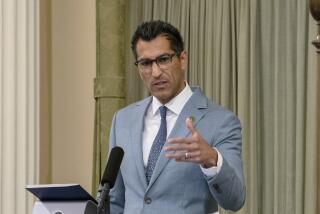Op-Ed: How will voters cope with 17 state propositions on the November ballot? They’ll probably just say no
This fall, in addition to casting a vote in the presidential contest including Republican Donald Trump and Democrat Hillary Clinton, Californians will face the daunting task of determining the fate of 17 state propositions. Local ballots will add their own initiatives to this burden.
The range of issues will be extraordinary, including education funding, prescription drug pricing and criminal justice reform, as well as stricter gun laws, plastic bag bans and marijuana legalization. It’s been a dozen years since a ballot was as challenging (there were 16 state measures in 2004). How will voters respond?
Despite the demands direct democracy places on Californians, the state’s 105-year-old initiative system has not lost its luster. Surveys conducted by my organization, the Public Policy Institute of California, consistently show that about 70% of us say it is a good thing that a majority of voters can make laws and change public policies by passing initiatives. Californians have a high opinion of themselves as policymakers and hold elected officials in lower esteem: Six in 10 likely voters say the decisions made by the electorate are probably better than those made by the governor and Legislature.
However, as pleased as they are with direct democracy in the abstract, only a small minority — 11% — of California voters are “very satisfied” with the way the process actually works.
In the December PPIC survey, a majority of likely voters agreed with this statement: “There are too many propositions on the state ballot.” An even more widely held complaint involves the wording of ballot measures. In numerous surveys, most likely voters think the language on ballots is “often too complicated and confusing ... to understand what happens if the initiative passes.”
And there is another bipartisan concern: Most Californians consider it a given that initiatives are controlled “a lot” by special interests.
Faced with too many complex policy decisions and feeling deep distrust of the motives of initiative proponents, the states’ voters have erected a high bar for passing initiatives.
Since 2000, two-thirds of propositions placed on the state ballot by citizen initiative have failed. These measures have often been the ones defined by millions of dollars spent to sway votes — through billboard and TV advertising and mountains of contentious mailers. By contrast, most of the state propositions generated by the legislative process have easily passed. These measures typically arrive at the ballot after public debate in Sacramento, with some bipartisan support and therefore with little organized opposition.
Taking the long view, the Legislature should be looking for ways to ease the burden for voters in future elections.
We should expect the default option this fall to repeat the recent trend: Californians will vote “no” on initiatives when they’re faced with a barrage of conflicting information, disagreement about the effect of the measure and questions about proponents’ motives. The dollars spent by opponents to sow confusion and doubt will tend to matter more than the dollars spent by supporters to make the case for a change. Voting “no” may simply seem like the safer choice. The initiative system gives the people the power to make changes when there is legislative gridlock, but intense campaigning tends to thwart that power.
Voters have a wish list for improving the initiative process.
Eight in 10 want to know more about the funding sources for and against initiatives. (A new state law requiring the California secretary of state to post updates on the top 10 funders of the “yes” and “no” initiative campaigns should help with this.)
Three-quarters of likely voters want to see televised debates on initiatives.
And a majority look favorably on the idea of establishing an independent citizens’ commission that would hold public hearings and offer its own opinions, pro and con, on the most consequential of the initiatives. (Oregon has instituted a version of this process; Arizona and Massachusetts are experimenting with it as well.)
Taking the long view, the Legislature should be looking for ways to ease the burden for voters in future elections. For starters, they should revisit their decision in 2011 to move all initiatives off primary ballots and onto general election ballots. The idea was to decide measures in the elections that draw the most voters, but one result is the massive 2016 ballot.
The state’s elected representatives could also make more use of the 2014 law that allows time for the Legislature and initiative proponents to reach a compromise and pass a law on an issue before an initiative goes to people via the ballot. This year, only one initiative was diverted from the ballot through this process.
California voters would emphatically prefer fewer measures to vote on per ballot. After initiatives qualify, they want more and better information about the issues, especially from independent sources. And in particular, they want to be able to follow the money behind the propositions. But they don’t want to diminish the power of direct democracy. Californians are more than willing to keep making weighty decisions that will form the future of their state.
Mark Baldassare is president and chief executive of the Public Policy Institute of California, where he directs the institute’s Statewide Survey and holds a chair in public policy.
Follow the Opinion section on Twitter @latimesopinionand Facebook
MORE FROM OPINION
Have Jews abandoned their committment to social justice?
Homelessness is an emergency — but not like an earthquake
The FBI overshares with Congress on Clinton email investigation
More to Read
A cure for the common opinion
Get thought-provoking perspectives with our weekly newsletter.
You may occasionally receive promotional content from the Los Angeles Times.






